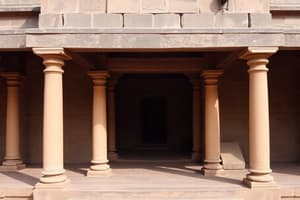Podcast
Questions and Answers
Nalanda University's curriculum included which of the following diverse fields of study?
Nalanda University's curriculum included which of the following diverse fields of study?
- Primarily medicine with a minor focus on fine arts.
- Buddhist studies, fine arts, medicine, and astronomy. (correct)
- Exclusively mathematics, politics, and military strategy.
- Only Buddhist studies and related religious practices.
What was a unique architectural feature of Nalanda University that supported its academic community?
What was a unique architectural feature of Nalanda University that supported its academic community?
- A large amphitheater for public debates and theatrical performances.
- Underground tunnels connecting temples to meditation halls.
- Dormitories to house a large number of students and professors. (correct)
- A central market for scholars to trade goods and services.
What signifies Nalanda's importance as a site connected to the Buddha?
What signifies Nalanda's importance as a site connected to the Buddha?
- It was the location of Buddha's enlightenment.
- Buddha often visited the site, and two of his chief disciples were from the area. (correct)
- It was built by the Buddha to disseminate knowledge.
- It was the location where Buddha delivered his first sermon.
Which event led to the decline of Nalanda University in the 12th century?
Which event led to the decline of Nalanda University in the 12th century?
Alexander Cunningham's contribution to the history of Nalanda University was that he:
Alexander Cunningham's contribution to the history of Nalanda University was that he:
Around what time frame did Nalanda serve as a center for Buddhist studies?
Around what time frame did Nalanda serve as a center for Buddhist studies?
What fields of study distinguished Takshashila from other ancient universities?
What fields of study distinguished Takshashila from other ancient universities?
What signifies the historical importance of Takshashila?
What signifies the historical importance of Takshashila?
The decline of Takshashila as a center of learning can be attributed to:
The decline of Takshashila as a center of learning can be attributed to:
How do the ruins of Taxila reflect its historical stages?
How do the ruins of Taxila reflect its historical stages?
What role did Hsuan Tsang play in the history of Nalanda University?
What role did Hsuan Tsang play in the history of Nalanda University?
What was typically the age of entry for students at Takshashila, indicating the level of prior education assumed?
What was typically the age of entry for students at Takshashila, indicating the level of prior education assumed?
Besides Buddhism and academics, what other purpose did Nalanda University serve, indicating its broad impact on society?
Besides Buddhism and academics, what other purpose did Nalanda University serve, indicating its broad impact on society?
What inference can be made about the religious harmony at Takshashila, considering its historical status?
What inference can be made about the religious harmony at Takshashila, considering its historical status?
What does the presence of 'stupas' and 'monasteries' in the ruins of Taxila suggest about its cultural landscape?
What does the presence of 'stupas' and 'monasteries' in the ruins of Taxila suggest about its cultural landscape?
What does the reference to 'Jataka tales' in the context of Takshashila indicate about the nature of historical accounts available?
What does the reference to 'Jataka tales' in the context of Takshashila indicate about the nature of historical accounts available?
How did the library at Nalanda University support advanced research and scholarship?
How did the library at Nalanda University support advanced research and scholarship?
What can be inferred about the scope of education in ancient India from Nalanda University attracting students from regions like Korea, Japan, and China?
What can be inferred about the scope of education in ancient India from Nalanda University attracting students from regions like Korea, Japan, and China?
Which of the following figures associated with Takshashila is most closely linked to political strategy and statecraft?
Which of the following figures associated with Takshashila is most closely linked to political strategy and statecraft?
Why is the excavation of Nalanda University considered incomplete, hinting towards further historical revelations?
Why is the excavation of Nalanda University considered incomplete, hinting towards further historical revelations?
Flashcards
Nalanda University
Nalanda University
An ancient center of higher learning in Bihar, India, established in the 5th century AD and survived until 1197.
Nalanda's Importance
Nalanda's Importance
The main importance of Nalanda comes from its Buddhist roots as a center of learning.
Alexander Cunningham
Alexander Cunningham
Identified the site of Nalanda University in the 1860s and archaeological work began in 1915-1916.
Takshashila University
Takshashila University
Signup and view all the flashcards
Arthashastra
Arthashastra
Signup and view all the flashcards
Taksa
Taksa
Signup and view all the flashcards
Hathial Area
Hathial Area
Signup and view all the flashcards
Taxila's Main Ruins
Taxila's Main Ruins
Signup and view all the flashcards
Ruins of Taxila
Ruins of Taxila
Signup and view all the flashcards
Bakhtiyar Khalji
Bakhtiyar Khalji
Signup and view all the flashcards
Study Notes
- India has ancient universities
Ancient Nalanda University
- Nalanda in Bihar, India, existed as a center of higher learning from 427 to 1197 AD
- The university was established in the 5th century AD
- Nalanda stood near the southern border of Nepal
- Nalanda was devoted to Buddhist studies
- Students could study fine arts, medicine, mathematics, astronomy, politics, and the art of war
- Nalanda had eight separate compounds
- The compounds included 10 temples, meditation halls, classrooms, lakes, and parks
- The university housed a nine-story library
- Monks copied books and documents
- Individual scholars had their own collections
- It had dormitories for students
- 10,000 students lived at the university during its peak
- There were accommodations for 2,000 professors
- Students came from Korea, Japan, China, Tibet, Indonesia, Persia, and Turkey
- Nalanda is a half-hour bus ride from Rajgir
- Nalanda is considered the world's first university.
- It was a pilgrimage destination from the 1st Century AD
- The Buddha often visited the site
- Two of Buddha's chief disciples, Sariputra and Moggallana, came from the area
- The large stupa is Sariputra's Stupa, marking where his relics are entombed and where he was supposedly born
- The site has small monasteries where monks lived and studied
- Many monasteries were rebuilt over the centuries
- One of the cells belonged to Naropa
- Naropa helped spread Buddism to Tibet
- Other Nalanda figures were Shantirakshita and Padmasambhava
- A tiny room in the cell is where Naropa supposedly meditated
- Nalanda's importance comes from its Buddhist roots as a center of learning
- Hsuan Tsang from China studied and taught there for 5 years in the 7th Century AD
- Nalanda University had over 10,000 students and 3,000 teachers at that time
- Nalanda was a center of scholarship and Buddhist studies in the ancient world for 700 years between the 5th and 12th centuries
- A fire wiped out the library of over 9 million manuscripts
- A Muslim invader, Bakhtiyar Khalji, sacked the university at the beginning of the 12th Century
- Alexander Cunningham identified the site as Nalanda University in the 1860s
- The Archeological Survey of India began excavations of the site in 1915-1916
- Only a small part of the entire site has been excavated to date
- Much of the ruins are beneath existing villages and are unlikely to be revealed
- A small museum with excellent Buddhist statues is across the street
- A temple dedicated to Hsuan Tsang is about a kilometer away
- The International Centre for Buddhist Studies and the Nava Nalanda Mahivihara, are set up for Buddhist research
Ancient Takshashila University
- Takshashila was an early Buddhist center of learning dating back to at least the 5th century BC
- Some scholars date Takshashila's existence back to the 6th century BC
- Takshashila is described in Jātaka tales around the 5th century AD
- It was a noted center of learning several centuries before Christ
- It continued to attract students until the city's destruction in the 5th century AD
- Takshashila is known for its association with Chanakya
- The Arthashastra by Chanakya was composed there
- Chanakya (also known as Kautilya), the Maurya Emperor Chandragupta, and the Ayurvedic healer Charaka studied at Taxila
- Students entered Takshashila at age sixteen
- The school taught the Vedas and the Eighteen Arts
- Students could study skills such as archery, hunting, and elephant lore
- Students could study law, medicine, and military science
- The ruins of Taxila include buildings and Buddhist stupas
- The ruins are divided into three major cities, each from a distinct time period
- The oldest is the Hathial area, dating between the 6th century BCE and the late 2nd millennium BCE
- Bhir Mound dates from the 6th century BCE
- The second city of Taxila is located at Sirkap dating to the 2nd century BCE
- Sirkap was built by Greco-Bactrian kings
- The third city of Taxila is at Sirsukh and relates to the Kushan kings
- Ruins in the Taxila area include ruins of the stupa at Dharmarajika, the monastery at Jaulian, the monastery at Mohra Muradu, in addition to stupas
- Legend says Takṣa, an ancient king founded Takṣaśilā which was Takṣa Khanda
- Sanskrit Takṣaśilā, contains the suffix śilā which means stone
- The prefix Takṣa alludes to Takṣa, son of Bharata and Mandavi, as related in the Ramayana
- The Kuru heir Parikṣit was enthroned at Takṣaśilā
- The Mahabharata was first recited at Takṣaśilā by Vaishampayana, a disciple of Vyasa
- The recitation occurred at the sarpa satra yajna, "Snake Sacrifice ceremony" of Parikṣit's son Janamejaya
- Takṣaśilā is related to Takşaka, "carpenter" and is an alternative name for the Nāgas of ancient India
- Takshashila is considered a place of religious and historical sanctity by Hindus and Buddhists
- Takshashila was the seat of Vedic learning
- Chanakya, a senior teacher there, helped consolidate the empire of Emperor Chandragupta Maurya
- The Mahāyāna sect of Buddhism took shape there.
Other Universities in India
- Odantapuri was in Bihar (circa 550 - 1040)
- Somapura was in Bangladesh (from the Gupta period to the Muslim conquest)
- Jagaddala was in Bengal (from the Pala period to the Muslim conquest)
- Nagarjunakonda was in Andhra Pradesh
- Vikramaśīla was in Bihar (circa 800-1040)
- Sharada Peeth was in modern day Kashmir
- Valabhi was in Gujarat (from the Maitrak period to the Arab raids)
- Varanasi was in Uttar Pradesh (8th century to modern times)
- Kanchipuram was in Tamil Nadu
- Manyakheta was in Karnataka
- Puspagiri was in Orissa
- Ratnagiri was in Orissa
- Sunethradevi Pirivena was in Sri Lanka, founded circa 1415 AD
Studying That Suits You
Use AI to generate personalized quizzes and flashcards to suit your learning preferences.




